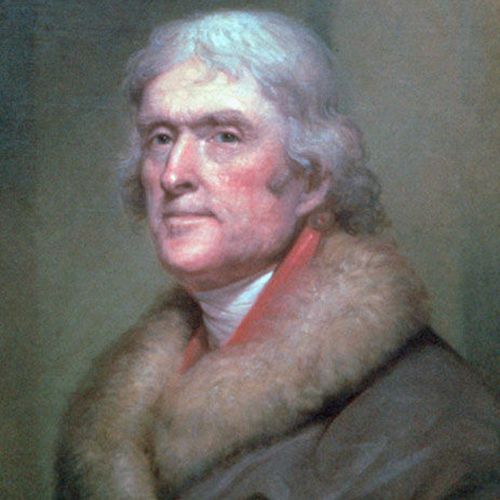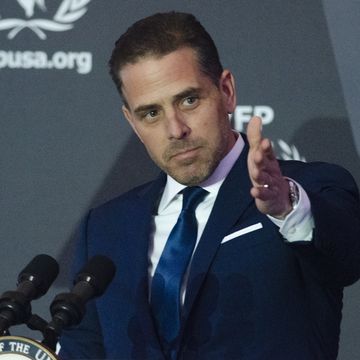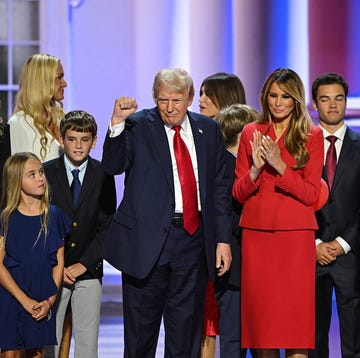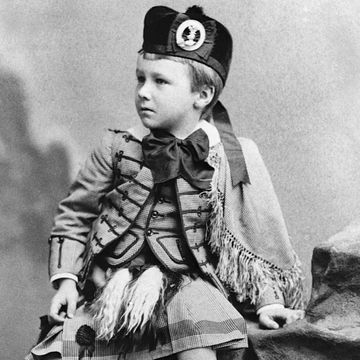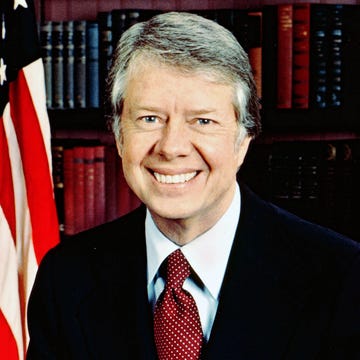1743-1826
Who Was Thomas Jefferson?
Thomas Jefferson was one of the Founding Fathers of the United States. The native Virginian was the primary author of the Declaration of Independence and later held several national offices. Jefferson served as the nation’s first secretary of state, and the second vice president (under John Adams), and the third American president, from 1801 to 1809. During his two-term presidency, Jefferson doubled the size of the United States by successfully brokering the Louisiana Purchase and defeated pirates from North Africa during the Barbary War. In retirement, Jefferson founded the University of Virginia and continued work on his beloved Monticello estate. He died on the 50th anniversary of the Declaration of Independence at age 83.
Jump to:
- Who Was Thomas Jefferson?
- Quick Facts
- When and Where Was Thomas Jefferson Born?
- Education
- Monticello
- Children, Wife, and Sally Hemings
- Declaration of Independence
- Virginia Governor and House Delegate
- National Appointments: Minister to France and Secretary of State
- Vice Presidency
- Accomplishments as U.S. President
- Ideology: Political Party, Views on Slavery, and Legacy
- Later Years: Founding the University of Virginia
- When Did Thomas Jefferson Die?
- Quotes
Quick Facts
FULL NAME: Thomas Jefferson
BORN: April 13, 1743
DIED: July 4, 1826
BIRTHPLACE: Shadwell, Virginia
SPOUSE: Martha Jefferson (1772-1782)
CHILDREN: 12
ASTROLOGICAL SIGN: Aries
When and Where Was Thomas Jefferson Born?
Thomas Jefferson was born on April 13, 1743, at the Shadwell plantation located just outside of Charlottesville, Virginia.
Thomas was born into one of the most prominent families of Virginia’s planter elite. His mother, Jane Randolph Jefferson, was a member of the proud Randolph clan, a family claiming descent from English and Scottish royalty. His father, Peter Jefferson, was a successful farmer as well as a skilled surveyor and cartographer who produced the first accurate map of the Province of Virginia.
Thomas was the third born of 10 siblings. As a boy, his favorite pastimes were playing in the woods, practicing the violin, and reading.
Education
Jefferson began his formal education at age 9, studying Latin and Greek at a local private school run by Reverend William Douglas. In 1757, at the age of 14, he took up further study of the classical languages as well as literature and mathematics with Reverend James Maury, whom Jefferson later described as “a correct classical scholar.”
In 1760, having learned all he could from Maury, Jefferson left home to attend the College of William and Mary in Williamsburg, Virginia’s capital. Although it was the second oldest college in America (after Harvard), William and Mary wasn’t an especially rigorous academic institution at that time. Jefferson was dismayed to discover that his classmates expended their energies betting on horse races, playing cards, and courting women rather than studying.
Nevertheless, the serious and precocious Jefferson fell in with a circle of older scholars that included Professor William Small, Lieutenant Governor Francis Fauquier, and lawyer George Wythe, and it was from them that he received his true education.
After three years at William and Mary, Jefferson decided to read law under Wythe, one of the preeminent lawyers of the American colonies. There were no law schools at this time; instead aspiring attorneys “read law” under the supervision of an established lawyer before being examined by the bar.
Wythe guided Jefferson through an extraordinarily rigorous five-year course of study—more than double the typical duration. By the time Jefferson won admission to the Virginia bar in 1767, he was already one of the most learned lawyers in America.
Monticello
In 1769, Jefferson began construction of what was perhaps his greatest labor of love: Monticello, his house atop a small rise outside of Charlottesville, Virginia. The house was built on land within the state’s Piedmont region that his father had owned since 1735.
In keeping with his interests as one of America’s greatest Renaissance Men—he liked botany, archaeology, music, and birdwatching, among other subjects—Jefferson, himself, drafted the blueprints for Monticello’s neoclassical mansion, outbuildings, and gardens.
More than just a residence, Monticello was also a working plantation, where Jefferson kept roughly 130 Black people in slavery. Their duties included tending gardens and livestock, plowing fields, and working at the onsite textile factory.
Now a museum centered on its original owner, Monticello is open to the public for tours. The property was designated as a National Historic Landmark in 1966 and a UNESCO World Heritage Site in 1987.
Children, Wife, and Sally Hemings
From 1767 to 1774, Jefferson practiced law in Virginia with great success, trying many cases and winning most of them. During these years, he also met and fell in love with Martha Wayles Skelton, a recent widow and one of the wealthiest women in Virginia.
The pair married on January 1, 1772. Thomas and Martha Jefferson had six children together, but only two survived into adulthood: Martha, their firstborn, and Mary, their fourth, who went by the name “Maria.” Only Martha survived her father.
His six children with Martha, however, weren’t the only kids Jefferson fathered. History scholars and a significant body of DNA evidence indicate that Jefferson had an affair—and several children—with Sally Hemings, one of his enslaved people and the elder Martha’s half-sister. (Sally’s mother, Betty Hemings, was enslaved by Mather’s father, John Wayles, who also fathered Sally.)
It’s overwhelmingly likely, if not absolutely certain, that Jefferson fathered all six of Sally Hemings’ children. Even the Thomas Jefferson Foundation, which owns and operates Monticello, has publicly acknowledged this and considers Jefferson’s paternity of Hemings’ children “settled historical matter.” The most compelling proof is DNA evidence, revealed in 1998, showing that some male member of the Jefferson family fathered Hemings’ children, and that it wasn’t Samuel or Peter Carr, the only two of Jefferson’s male relatives in the vicinity at the relevant times.
Only four of Jefferson and Hemings’ six children survived. William Beverly Hemings, Harriet Hemings, James Madison Hemings, and Thomas Eston Hemings were born into slavery, though Jefferson freed them. Still shrouded in history is the exact nature of Jefferson’s relationship with Sally, who was thirty years younger than the Founding Father.
Declaration of Independence
The beginning of Jefferson’s professional life coincided with major changes in Great Britain’s 13 American colonies. The conclusion of the French and Indian War in 1763 left Great Britain in dire financial straits; to raise revenue, the Crown levied a host of new taxes on its colonies in America. In particular, the Stamp Act of 1765, which imposed a tax on printed and paper goods, outraged the colonists, giving rise to the American revolutionary slogan, “No taxation without representation.”
Eight years later, on December 16, 1773, colonists protesting a British tea tax dumped 342 chests of tea into the Boston Harbor in what is known as the Boston Tea Party. In April 1775, American militiamen clashed with British soldiers at the Battles of Lexington and Concord, the first conflicts in what developed into the Revolutionary War.
Jefferson was one of the earliest and most fervent supporters of the cause of American independence from Great Britain. He was elected to the Virginia House of Burgesses in 1768 and joined its radical bloc, led by Patrick Henry and George Washington.
In 1774, Jefferson penned his first major political work, A Summary View of the Rights of British America, which established his reputation as one of the most eloquent advocates of the American cause. A year later, Jefferson traveled to Philadelphia to attend the Second Continental Congress, which created the Continental Army and appointed Washington as its commander-in-chief. However, the Congress’ most significant work fell to Jefferson himself.
In June 1776, the Congress appointed a five-man committee—Jefferson, John Adams, Benjamin Franklin, Roger Sherman, and Robert Livingston—to draft a Declaration of Independence. The committee then chose Jefferson to author the declaration’s first draft, selecting him for what Adams called his “happy talent for composition and singular felicity of expression.”
Over 17 days, Jefferson drafted one of the most beautiful and powerful testaments to liberty and equality in world history. The document opens with a preamble stating the natural rights of all human beings then continues on to enumerate specific grievances against King George III that absolved the American colonies of any allegiance to the British Crown.
Although the version of the Declaration of Independence adopted on July 4, 1776, had undergone a series of revisions from Jefferson’s original draft, its immortal words remain essentially his own:
“We hold these truths to be self-evident, that all men are created equal, that they are endowed by their Creator with certain unalienable Rights; that among these are Life, Liberty, and the pursuit of Happiness.”
Virginia Governor and House Delegate
After authoring the Declaration of Independence, Jefferson returned to Virginia, where, from 1776 to 1779, he served as a member of the Virginia House of Delegates. There he sought to revise Virginia’s laws to fit the American ideals he had outlined in the Declaration of Independence. Jefferson successfully abolished the doctrine of entail, which dictated that only a property owner’s heirs could inherit his land, and the doctrine of primogeniture, which required that in the absence of a will a property owner’s oldest son inherited his entire estate.
On June 1, 1779, the Virginia legislature elected Jefferson as the state’s second governor. His two years as governor proved the low point of Jefferson’s political career. Torn between the Continental Army’s desperate pleas for more men and supplies and Virginians’ strong desire to keep such resources for their own defense, Jefferson waffled and pleased no one.
As the Revolutionary War progressed into the South, Jefferson moved the capital from Williamsburg to Richmond, only to be forced to evacuate that city when it, rather than Williamsburg, turned out to be the target of British attack.
On June 1, 1781, the day before the end of his second term as governor, Jefferson was forced to flee his home at Monticello, only narrowly escaping capture by the British cavalry. Although he had no choice but to leave, his political enemies later pointed to this inglorious incident as evidence of cowardice.
Jefferson declined to seek a third term as governor and stepped down on June 4, 1781. Claiming that he was giving up public life for good, he returned to Monticello, where he intended to live out the rest of his days as a gentleman farmer surrounded by the domestic pleasures of his family, his farm, and his books. But the next year, Jefferson was spurred back into public life by private tragedy: the untimely death of his beloved wife, Martha, on September 6, 1782, about six weeks before her 34th birthday.
National Appointments: Minister to France and Secretary of State
After months of mourning, in June 1783, Jefferson returned to Philadelphia to lead the Virginia delegation to the Confederation Congress. In 1785, that body appointed Jefferson to replace Benjamin Franklin as the U.S. minister to France. His official duties as minister consisted primarily of negotiating loans and trade agreements with private citizens and government officials in Paris and Amsterdam.
Although Jefferson appreciated much about European culture—its arts, architecture, literature, food, and wines—he found the juxtaposition of the aristocracy’s grandeur and the masses’ poverty repellant. “I find the general fate of humanity here, most deplorable,” he wrote in one letter.
In Europe, Jefferson rekindled his friendship with John Adams, who served as minister to Great Britain, and his wife, Abigail Adams. The educated and erudite Abigail, with whom Jefferson maintained a lengthy correspondence on a wide variety of subjects, was perhaps the only woman he ever treated as an intellectual equal.
After nearly five years in Paris, Jefferson returned to America at the end of 1789 with a much greater appreciation for his home country. As he wrote to his good friend James Monroe, “My God! How little do my countrymen know what precious blessings they are in possession of, and which no other people on earth enjoy.”
Jefferson arrived in Virginia in November 1789 to find George Washington waiting for him with news that Washington had been elected the first president of the United States of America and that he was appointing Jefferson as his secretary of state. Besides Jefferson, Washington’s most trusted advisor was Treasury Secretary Alexander Hamilton. A dozen years younger than Jefferson, Hamilton was a New Yorker and war hero who, unlike Jefferson and Washington, had risen from humble beginnings.
Rancorous partisan battles emerged to divide the new American government during Washington’s presidency. On one side, the Republican Party, led by Jefferson, promoted the supremacy of state governments, a strict constructionist interpretation of the U.S. Constitution, and support for the French Revolution. On the other side, the Federalists, led by Alexander Hamilton, advocated for a strong national government, broad interpretation of the Constitution, and neutrality in European affairs.
Washington’s two most trusted advisors thus provided nearly opposite advice on the most pressing issues of the day: the creation of a national bank, the appointment of federal judges, and the official posture toward France. On January 5, 1794, frustrated by the endless conflicts, Jefferson resigned as secretary of state, once again abandoning politics in favor of his family and farm at his beloved Monticello.
Vice Presidency
Despite Jefferson’s public ambivalence and previous claims that he was through with politics, the Republicans selected Jefferson as their candidate to succeed George Washington as president. In those days, candidates didn’t campaign for office openly, so Jefferson did little more than remain at home on the way to finishing a close second to then–Vice President John Adams in the electoral college vote. By the rules of the time, that made Jefferson the new vice president. He held the post from 1797 to 1801.
Besides presiding over the U.S. Senate, the vice president had essentially no substantive role in government. The long friendship between Adams and Jefferson had cooled due to political differences (Adams was a Federalist), and Adams didn’t consult his vice president on any important decisions.
To occupy his time during his four years as vice president, Jefferson authored A Manual of Parliamentary Practice, one of the most useful guides to legislative proceedings ever written, and served as the president of the American Philosophical Society.
Accomplishments as U.S. President
John Adams’ presidency revealed deep fissures in the Federalist Party between moderates such as Adams and George Washington and more extreme Federalists like Alexander Hamilton. In the presidential election of 1800, the Federalists refused to back Adams, clearing the way for the Republican candidates Jefferson and Aaron Burr to tie for first place, with 73 electoral votes each. After a long and contentious debate, the U.S. House of Representatives selected Jefferson to serve as the third president of America, with Burr as his vice president.
The election of Jefferson in 1800 was a landmark of world history: the first peacetime transfer of power from one party to another in a modern republic. Delivering his inaugural address on March 4, 1801, Jefferson spoke to the fundamental commonalities uniting all Americans despite their partisan differences. “Every difference of opinion is not a difference of principle,” he stated. “We have called by different names brethren of the same principle. We are all Republicans, we are all Federalists.”
First Term
President Jefferson’s accomplishments during his first term in office, from 1801 to 1805, were numerous, remarkably successful, and productive. In keeping with his Republican values, Jefferson stripped the presidency of all the trappings of European royalty, reduced the size of the armed forces and government bureaucracy, and lowered the national debt from $80 million to $57 million in his first two years in office.
Nevertheless, Jefferson’s most important achievements as president all involved bold assertions of national government power and surprisingly liberal readings of the Constitution.
Louisiana Purchase
Jefferson’s most significant accomplishment as president was the Louisiana Purchase. In 1803, he acquired land stretching from the Mississippi River to the Rocky Mountains from cash-strapped Napoleonic France for the bargain price of $15 million, thereby doubling the size of the nation in a single stroke. He then devised the wonderfully informative Lewis and Clark Expedition to explore, map out, and report back on the new American territories.
Tripoli Pirates
Jefferson also put an end to the centuries-old problem of Tripoli pirates from North Africa disrupting American shipping in the Mediterranean. During the Barbary War, Jefferson forced the pirates to capitulate by deploying new American warships.
Notably, both the Louisiana Purchase and the undeclared war against the Barbary pirates conflicted with Jefferson’s much-avowed Republican values. Both actions represented unprecedented expansions of national government power, and neither was explicitly sanctioned by the Constitution.
Second Term
Although Jefferson easily won re-election in 1804, his second term in office proved much more difficult and less productive than his first. He largely failed in his efforts to impeach the many Federalist judges swept into government by the Judiciary Act of 1801.
However, the greatest challenges of Jefferson’s second term were posed by the war between Napoleonic France and Great Britain. Both Britain and France attempted to prevent American commerce with the other power by harassing American shipping. Britain, in particular, sought to impress American sailors into the British Navy.
In response, Jefferson passed the Embargo Act of 1807, suspending all trade with Europe. The move wrecked the American economy as exports crashed from $108 million to $22 million by the time he left office in 1809. The embargo also led to the War of 1812 with Great Britain after Jefferson left office.
Ideology: Political Party, Views on Slavery, and Legacy
Jefferson was the first leader of the Republican Party, which formed in the 1790s and became the Democratic-Republican Party before the end of the decade. Jeffersonian Republicans advocated for a smaller federal government, encouraged states’ rights and individual liberties, and favored a strict interpretation of the U.S. Constitution. Jefferson was the first of three Democratic-Republican presidents, followed by James Madison and James Monroe. The party eventually evolved into the modern-day Democratic Party.
Beyond his positions and actions while in public office, Jefferson offered a window into his political philosophy and worldview through his only full-length book, Notes on the State of Virginia. He began writing the book in late 1781 after stepping down as the governor of Virginia and ostensibly sought to outline the history, culture, and geography of his home state. However, Notes on the State of Virginia also contained Jefferson’s vision of the good society he hoped America would become: a virtuous agricultural republic based on the values of liberty, honesty, and simplicity and centered on the self-sufficient yeoman farmer.
Views on Slavery
Jefferson’s writings shed light on his contradictory, controversial, and much-debated views on race and slavery. Jefferson was a slave owner his entire life, and his very existence as a gentleman farmer depended on the institution of slavery.
Like most white Americans of that time, Jefferson held views we would now describe as nakedly racist: He believed that Black people were innately inferior to white people in terms of both mental and physical capacity.
Nevertheless, he claimed to abhor slavery as a violation of the natural rights of man. He saw the eventual solution of America’s race problem as the abolition of slavery followed by the exile of formerly enslaved people to either Africa or Haiti, because, he believed, the formerly enslaved couldn’t live peacefully alongside their former masters.
As Jefferson wrote, “We have the wolf by the ears, and we can neither hold him nor safely let him go. Justice is in one scale, and self-preservation in the other.”
Democratic Legacy
Jefferson will be forever revered as one of the great American Founding Fathers. As the primary author of the Declaration of Independence, Jefferson wrote the foundational text of American democracy and one of the most important documents in world history. He also wrote about other key democratic ideals, including:
- The separation of church and state: In 1777, Jefferson wrote the Virginia Statute for Religious Freedom, which established freedom of religion and the separation of church and state. Although the document wasn’t adopted as Virginia state law for another nine years, it was one of Jefferson’s proudest life accomplishments.
- Legislative procedures: Jefferson’s A Manual of Parliamentary Practice (1801) established more granular rules for America’s legislative bodies than had been previously outlined. He was inspired to study the subject while serving as vice president, which involved overseeing the U.S. Senate. His rules are still active influences in the Senate and the U.S. House of Representatives.
Ultimately, Jefferson was a man of many contradictions. He was the spokesman of liberty and a racist slave owner, a champion of the common people and a man with luxurious and aristocratic tastes, a believer in limited government and a president who expanded governmental authority beyond the wildest visions of his predecessors, a quiet man who abhorred politics and arguably the most dominant political figure of his generation. The tensions between Jefferson’s principles and practices make him all the more apt a symbol for the nation he helped create, a nation whose shining ideals have always been complicated by a complex history.
Later Years: Founding the University of Virginia
On March 4, 1809, after watching the inauguration of his close friend and successor James Madison, Jefferson returned to Virginia to live out the rest of his days as “The Sage of Monticello.”
His primary pastime was endlessly rebuilding, remodeling, and improving his home and estate, at considerable expense. A Frenchman named Marquis de Chastellux quipped, “it may be said that Mr. Jefferson is the first American who has consulted the Fine Arts to know how he should shelter himself from the weather.”
Jefferson also dedicated his later years to organizing the University of Virginia, the nation’s first secular university. He personally designed the campus, envisioned as an “academical village” in Charlottesville, and hand-selected renowned European scholars to serve as its professors. The University of Virginia opened its doors on March 7, 1825, one of the proudest days of Jefferson’s life.
At the end of his life, the former president kept up an outpouring of correspondence. In particular, he rekindled a lively correspondence on politics, philosophy, and literature with John Adams that stands out among the most extraordinary exchanges of letters in history.
Nevertheless, Jefferson’s retirement was marred by financial woes. To pay off the substantial debts he incurred over decades of living beyond his means, Jefferson resorted to selling his cherished personal library to the national government to serve as the foundation of the Library of Congress.
When Did Thomas Jefferson Die?
Jefferson died on July 4, 1826—the 50th anniversary of the Declaration of Independence—at his Monticello estate near Charlottesville, Virginia.
His death occurred only a few hours before fellow Founding Father John Adams passed away in Massachusetts. In the moments before he passed, Adams spoke his last words, eternally true though not in the literal sense he meant them: “Thomas Jefferson survives.”
Jefferson is buried in the family cemetery at his beloved Monticello, in a grave marked by a plain gray tombstone. The brief inscription it bears, written by Jefferson, himself, is as noteworthy for what it excludes as what it includes. It suggests his humility as well as his belief that his greatest gifts to posterity came in the realm of ideas rather than the realm of politics:
“Here was buried Thomas Jefferson, author of the Declaration of American Independence of the Virginia Statute for Religious Freedom, and father of the University Of Virginia.”
The former president’s likeness appears on the U.S. nickel and on Mount Rushmore. The Thomas Jefferson Memorial in Washington, D.C., was dedicated in 1943 and took architectural influence from Jefferson’s designs at Monticello and the University of Virginia.
Quotes
- We have the wolf by the ears, and we can neither hold him nor safely let him go. Justice is in one scale, and self-preservation in the other.
- All tyranny needs to gain a foothold is for people of good conscience to remain silent.
- How little do my countrymen know what precious blessings they are in possession of, and which no other people on earth enjoy.
- Every difference of opinion is not a difference of principle. We have called by different names brethren of the same principle. We are all Republicans, we are all Federalists.
- The natural progress of things is for liberty to yield and government to gain ground.
- I hold it that a little rebellion now and then is a good thing, and as necessary in the political world as storms in the physical.
- I find friendship to be like wine, raw when new, ripened with age, the true old man’s milk and restorative cordial.
- I cannot live without books; but fewer will suffice where amusement, and not use, is the only future object.
- The tree of liberty must be refreshed from time to time with the blood of patriots and tyrants.
- All, too, will bear in mind this sacred principle, that though the will of the majority is in all cases to prevail, that will to be rightful must be reasonable; that the minority possess their equal rights, which equal law must protect, and to violate would be oppression.
- I like the dreams of the future better than the history of the past.
- [A] wise and frugal government, which shall restrain men from injuring one another, shall leave them otherwise free to regulate their own pursuits of industry and improvement, and shall not take from the mouth of labor the bread it has earned.
- I know well that no man will ever bring out of that office the reputation which carries him into it.
Fact Check: We strive for accuracy and fairness. If you see something that doesn’t look right, contact us!
The Biography.com staff is a team of people-obsessed and news-hungry editors with decades of collective experience. We have worked as daily newspaper reporters, major national magazine editors, and as editors-in-chief of regional media publications. Among our ranks are book authors and award-winning journalists. Our staff also works with freelance writers, researchers, and other contributors to produce the smart, compelling profiles and articles you see on our site. To meet the team, visit our About Us page: https://www.biography.com/about/a43602329/about-us
